How do you build a writing portfolio from scratch as a beginner?
The big question for new freelance writers.
You need a freelance writing portfolio.

This is a sample of your writing in the industry or topic you want to get paid for.
You need to have a writing niche to write samples for your writing portfolio, but it’s not required.
A freelance writing prospect typically won’t hire you unless they have read your writing in the niche they require. You can click the image below to view it better.
A recent prospect let me know that they read my writing samples on my writing portfolio page on my site. My samples told them that they liked my style and wanted to hire me this year.
Having a solid professional-looking writing portfolio filled with your best writing can really make or break you as a writer trying to make this a business.
So, let’s dive into all of this and see what the best way is to build your portfolio.
What is a Writing Portfolio?
A freelance writing portfolio holds your best writing article samples as a freelance writer. It demonstrates your writing skill in your niche topic and shows off the places you have written for.
You can house your one on your blog – the best place – or on a writing portfolio site like Contently or LinkedIn.
But if you have no experience as an online writer, how can you create a professional portfolio?
I’ll go through exactly how but to tell you in one sentence: The best way is to create up to three writing samples that showcases your wonderful online writing in the industry or topic you want to write for.
So, the key to all of this is to have writing samples online.
Learn in this video about how to create a portfolio step-by-step
Does your writing portfolio have to house EVERY piece of writing you’ve ever done?
No.
It should only have relevant, up-to-date content that showcases your best writing ability in the writing niche or niches you want to write for.
On mine, I share writing samples for different topics I enjoy writing about – digital marketing, blogging, social media, WordPress and personal development.
But is it okay NOT to have a portfolio of your articles?
No, I don’t think so and neither does freelance writer Kaitlyn Arford thinks so. Not having a writing portfolio is a barrier.
“I think that not having a portfolio hurts creatives looking for work! You have to look professional online, because hiring managers are reviewing your LinkedIn, your portfolio, and your online presence (aka Googling you) to decide if they should work with you.”
My Freelance Writing Portfolio Example
There are many ways you can display your freelance writer portfolio as I mentioned.
By far the best way is a page on your writer website.
Here’s what mine looks like.

You can just add links to your this page or stylize it using a page builder or using WordPress’s editor.
To me, this is the most professional way to display your content writing portfolio to potential clients.
So, a writing portfolio template might look like this:
- Niche focus (ex: Digital marketing)
- Feature Thumbnail Image
- Site name
- Title
- Link to published article
Let’s look at more writing portfolio examples to help you house your samples or clips.
Other freelance writing portfolio examples are based on social media.
Every freelance writer NEEDS a LinkedIn portfolio as well as your writer website.
Here is mine:
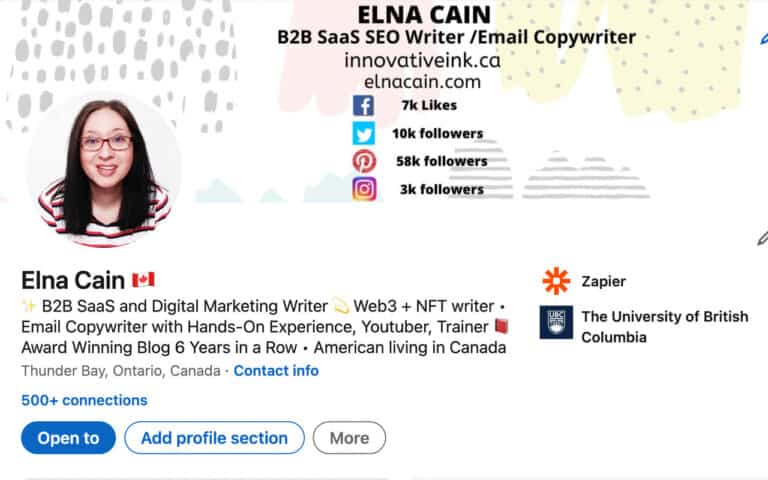

Why is LinkedIn a good place to house your freelance writing jobs?
Because many brands and companies are on LinkedIn and as Andy Strote shares, having a LinkedIn portfolio can help you rank in Google!
“A big reason to be on LinkedIn: Google loves it. Build your profile, with your portfolio on LinkedIn. Work your network. It will show up at the top of most searches. Take advantage of that.”
And, as freelancer Maggie Aime pointed out, you get work from your profile.
“I have a LI portfolio and had a handful of inbound leads.”
To add a portfolio item to LinkedIn:
- Under Experience in your resume section of your profile, click on the + up on the right corner
- Pick add a position
- From here, fill out all the necessary information
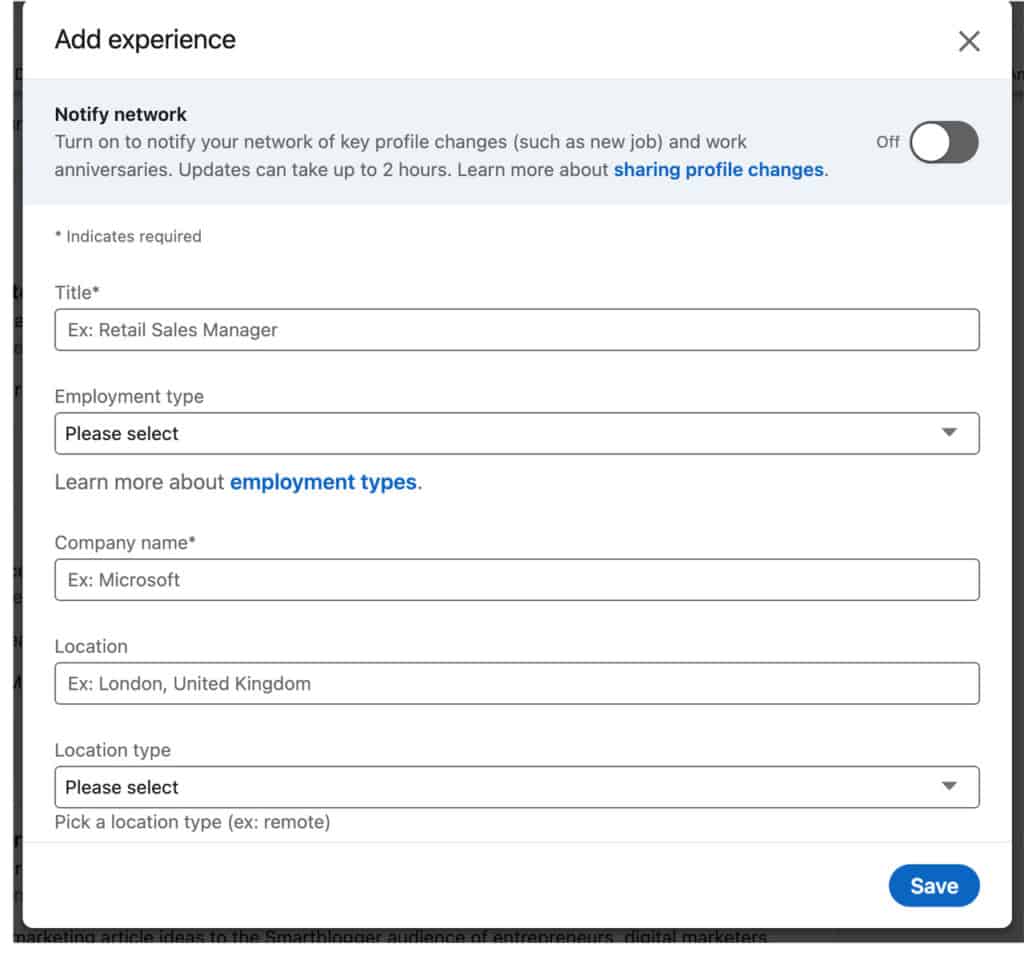
- At the bottom, click on add media
- Add the link to your published article on your client’s blog or guest blog
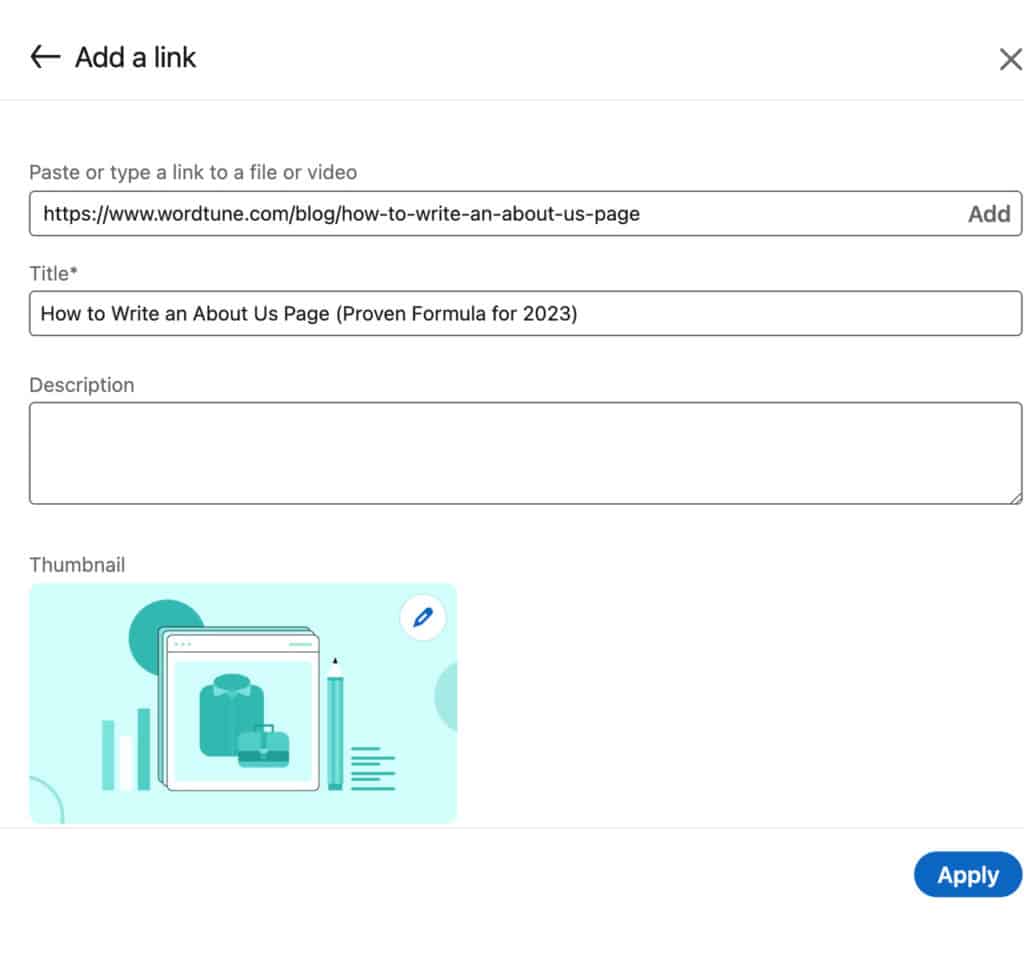
- Click apply and there you go
Why do you need more than one if you will most likely link to your website’s portfolio page in your pitches?
Because companies use LinkedIn and they find writers on LinkedIn.
If you optimized your LinkedIn portfolio, you’ll gain writing gigs.
There is also an option to use your LinkedIn profile as a resume by going to your profile, clicking on more and then clicking on creating from profile.
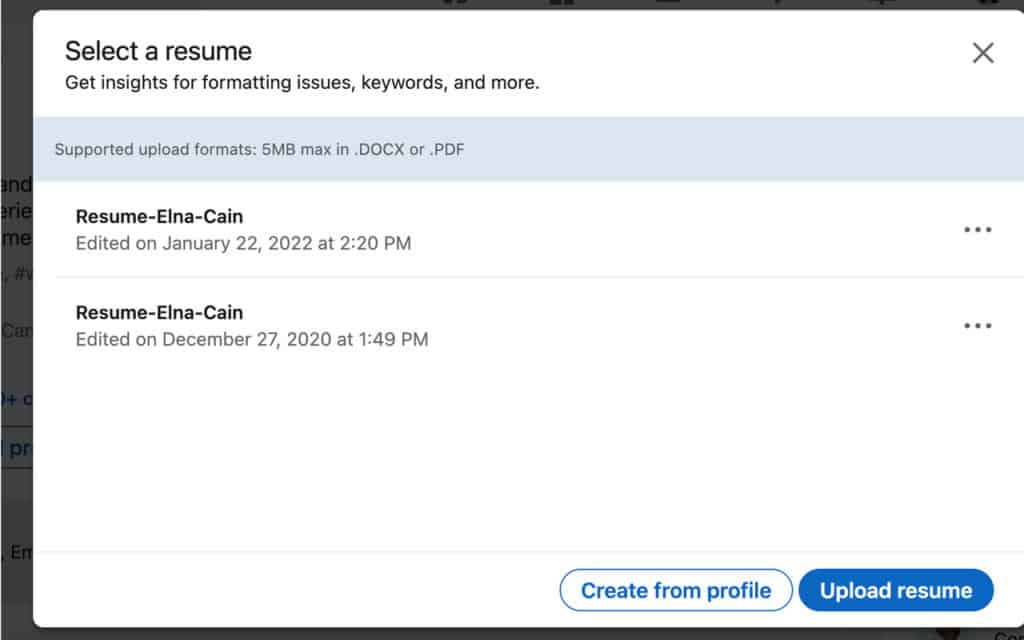
LinkedIn is free to sign up but you can only have one LinkedIn profile.
If you already have one for your current job, you might have to hold off on creating a LinkedIn portfolio and use another portfolio site.
Medium
Later on I will talk more about Medium, but for now, know that Medium is one of the writing portfolio sites where you can house writing samples.
Here is mine profile:
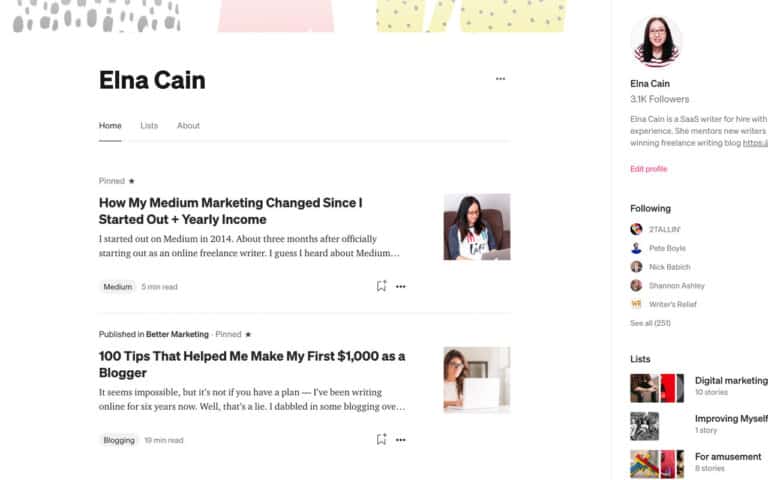
Over the years, Medium has become a “must-have” for a freelance writer in terms of housing your writer clips and using it as a portfolio to share with potential clients.
Many businesses are using Medium and I’ve heard of writers who write speciality topics like cryptocurrency, land writing jobs.
You can also connect with other writers too!
Freelance writer Anna Aksenovich says,
“I use Medium as my portfolio. The great thing about it that it also has a big community of writers and audience too so while being a portfolio your pieces can also get additional exposure.”
Go ahead and sign up to Medium!
After that, here’s how to add a writer sample item to Medium:
- For a published article (like an article from your blog that you own), go to Stories > import story
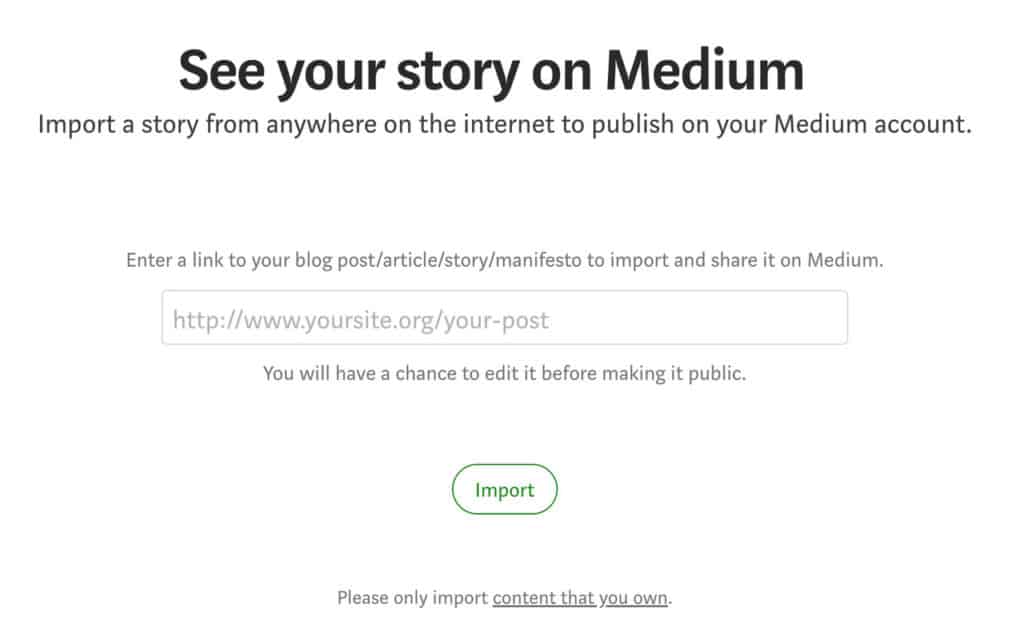
- If you want to create a writing sample on Medium, go to the pencil icon next to your profile picture.
- Add a title, subtile, and start writing (or pasting what you wrote on a Google Doc)

So, what is the best writing portfolio websites from my list?
I strongly feel your writer website portfolio page should show the most up-to-date writing and should be the one page you link out to in your pitches.
Are There Other Ways to Create a Writing Portfolio Online?
Yes!
While I have never used these sites, many other writers have.
Here are 4 more portfolio websites to check out.
- Journo Portfolio – they have a free tier where you can host 10 portfolio items
- Clippings.me – a free website portfolio builder. Just add a biography, customize your pate, add your writing work and there you go!
- Writerfolio – although it’s free to create (no sign up needed), it does cost $4/month.
- Writer’s Residence – there’s a free 30-day trial for this easy-to-use free portfolio builder
The Articles to Use in Your Freelance Writing Portfolio
So, do you only put blog posts in your writing portfolio?
No. You put the type of articles you want to get paid for. This might mean:
- sample emails for a copywriting portfolio
- mock-ups of white papers
- site content for an About page
- blog post
- magazine article
I typically write blog posts, so my writing portfolio is made up of blog content.
I also think this is the easiest type of content to create and to market for your business. You can land regular work as a freelance blogger.
So, if you want to have a technical writing portfolio, you would have writing samples about standard operating procedures or specific tech content for a certain industry like health.
If you want a creative writing portfolio, I would share links to any projects you have like a book or poems. You can also share editorial content (an op-ed) with a creative slant for a certain industry.
But, should you just draft up samples in Google doc or is there a better way to create a writing portfolio? Yes!!
How to Make a Writing Portfolio From Scratch
The best way to create a writing sample for your portfolio is to guest post.
This means your post is published on someone else’s blog. It can be paid contributions, but more often than not, it’s a free opportunity for you to market your business in front of a brand new targeted audience.
Guest posting also gives you the ‘street cred’ as a professional freelance writer.
How to build a writing portfolio with no experience doesn’t mean it’s impossible since you can guest post.
My first three writing samples were not really in my niche, nor were they at all related to each other.
The first was for A Nation of Moms. I wrote about gut health for toddlers. I thought natural health would be a good niche to get into. My second was for Social Media Today.
The Social Media article helped me break into the digital marketing niche – the niche I currently write in.
Finally, the third sample was for Psych Central on how to improve your mood. I was ecstatic for this sample as it was on a very prestigious platform, even though I wasn’t sure I wanted to write about mental health.
As you can see, not defining a niche didn’t stop me from writing about things I knew – natural health, mental health and social media (the last one I was learning at the time and wanted to write about it).
But, my suggestion for you for TODAY is to work on creating samples that fall into one main industry. It’s okay to have two writing niches but to make good money, clients want an expert and not a jack of all trades.
So, how do you guest post to fill up your writing portfolio from scratch?
1. Run a Google Search
The easiest is to run a Google search on the niche you want to write for + “write for us.” Here is an example of dog blogs!
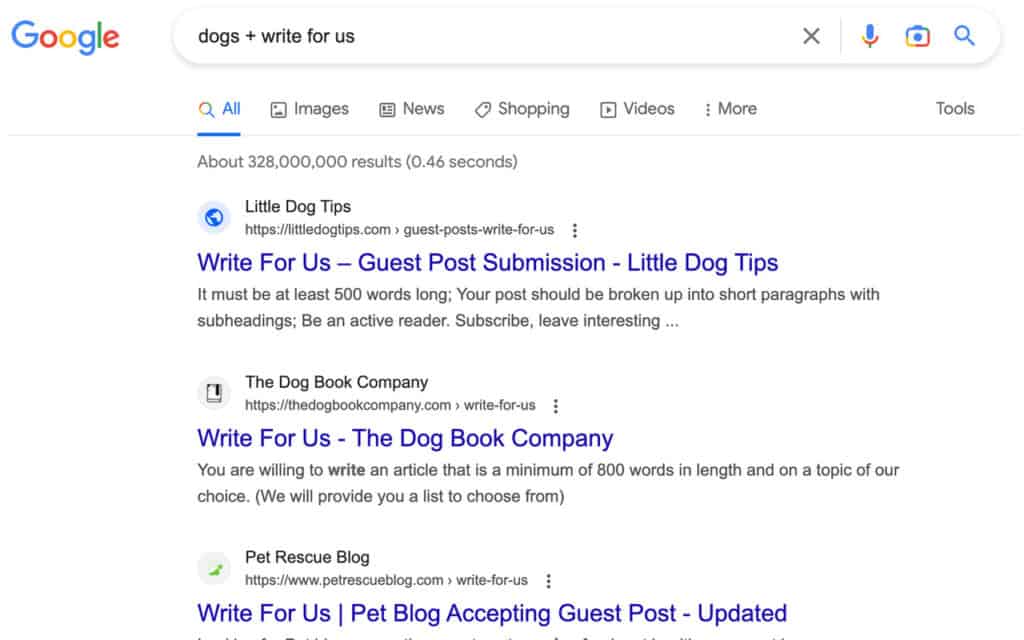
You can search for literally anything + write for us to get guest blog opportunities.
2. Read The Guest Blog’s Guidelines
Every place you guest blog for your writing portfolio will have a different set of guidelines to submit your post. Some may want a Google doc while others want you to send an attachment via email.
There may be strict rules on what types of links to include, who you can mention in your post and how to write your post and the length of the post. Here are The Abundant’s Artist’s guidelines.
Be careful of guidelines saying you have to PAY MONEY to THEM.
This is not necessary to create a freelance writing portfolio.
3. Create Your Guest Blog Pitch
Now comes the fun part – crafting your writing pitch based on the guidelines you just read!
Again, different blogs want different things. Some want 3-5 topic suggestions while others want an outline of one post idea.
Figure out what they want and come up with a great topic or list of topics.
Here is my pitch for A Nation of Moms:
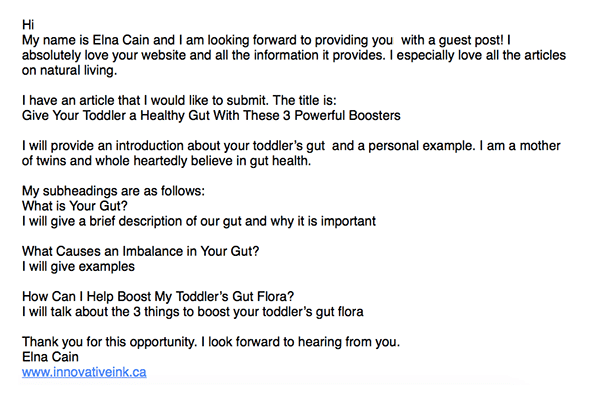
I suggest you research how to craft a pitch for guest blogging. It’s important that your pitch comes off personal and sounds like you know the blogger’s content.
Simply using a template for your guest pitch, won’t work in landing any guest posts.
Instead, read the blog you want to guest post and learn about:
- How long their posts are
- The format for their posts
- Their popular high sharing topics
- Their headlines
This information can help you stand out in your pitch. The blog owner will know you did your research.

4. Write the Guest Post
When you get accepted, it’s time to write the guest post. One thing to note – don’t pitch the SAME topic and outline to multiple guest blogs.
If you pitch the steps to eat paleo to five health blogs and two of them accept your pitch, you can’t write that post. And you can’t swap another idea either.
Instead, think of similar blog topics to pitch.
So, for the health example, if you want to guest post on a health site, come up with several ideas that can be similar if you have a hard time coming up with blog topics:
- 5 Steps to Get Your Family Eating Paleo
- Why Paleo Eating Isn’t Just a Fad
- 25 Easy Paleo Snacks to Take on The Run
- 5 Easy Ways You Can Start Eating Paleo
For a step-by-step tutorial on writing a guest post to help you build your writing portfolio from the ground up, check out my Youtube video.
5. Craft Your Author Bio
One of the best reasons you want to build your writer portfolio using guest posts is you get an author bio.
Your author bio is the place to market your freelance writing business!
A good bio has these components: what you are offering, what type of content you provide, how to reach you and some kind of way to tell your personality.
My author bio has evolved over the years as I’ve grown as a freelance writer. Here is my most current author bio:
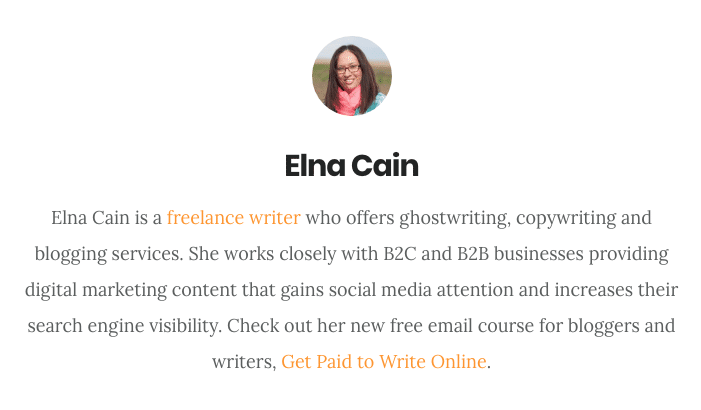
6. Submit Your Post And Wait
After you submit your post (via the way the blogger indicated in the guest post guidelines) it’s time to wait. You will probably get a response from the blog owner saying that they received it and give you a timeline of when your post will be published.
Other blogs may want you to edit and revise your content before they publish your post.
Once all of that is handled, you wait until your post is published.
During this time you can pitch for more guest spots, work on your writer website and start pitching to job boards.
As a new freelance writer, you gotta hustle every day. Figure out the tasks you need to do to get your business up and running!
7. Create Your Writing Portfolio (How to Format a Writing Portfolio)
You hear back! They published your guest post and you have a link now!
That’s great! Now you can create your writing portfolio.
Create a page in your WordPress site and name it Writing Portfolio or writing samples.
- Go to the backend of your WordPress site
- To go Pages > Add New
- Write the title and save for draft while you add your portfolio items
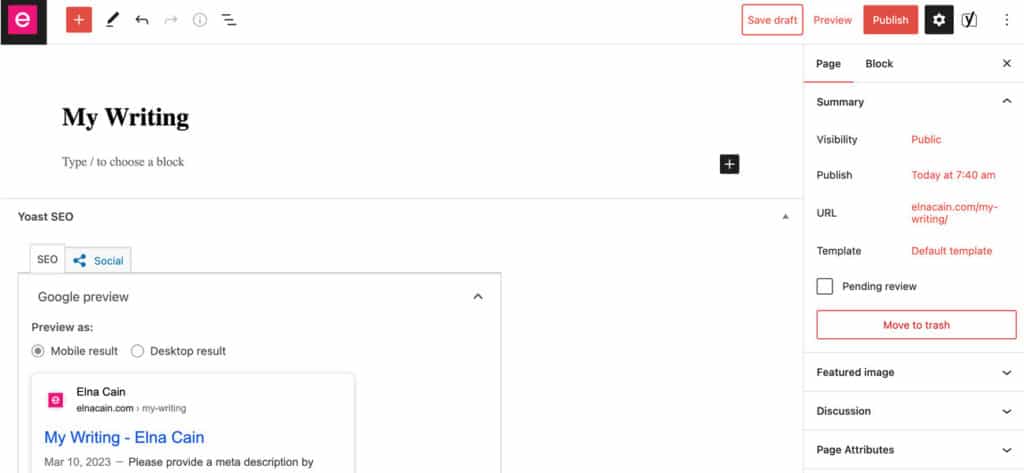
From there you can drop your link or stylize it with a page builder or with WordPress’ editor.
* I do have a detailed step-by-step lesson in Writer Website in a Weekend on creating all of your pages, including your portfolio page.
Here’s an example of using WordPress’s native builder Gutenberg, a page builder, to create a writing portfolio.
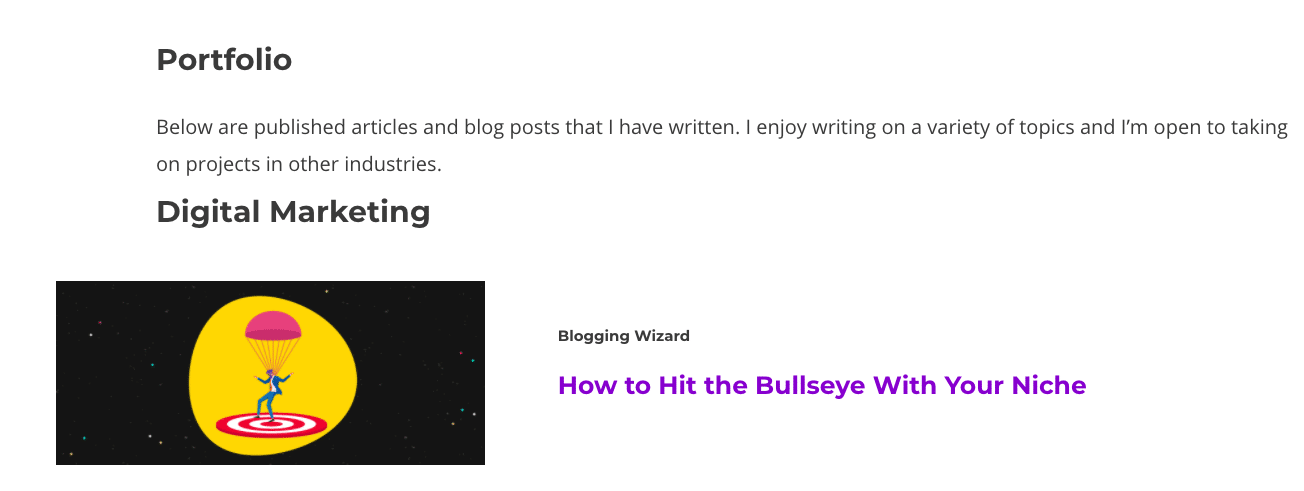
Now what?
8. Fill Up Your Writing Portfolio
You just have one writing portfolio item.
You need more!
My suggestion is to have at least 3 writing samples for your freelance portfolio to start out with. I would choose writing topics that are somewhat similar, unless you state different writing niches.
While guest posting is the best way to create a writing portfolio, another way is to create a Medium profile and submit your writing to publications on Medium.
Medium has thousands of publications that have submission sections. For these places, you don’t need to pitch, just sign up or send your draft link of your Medium post.
For example, here’s my piece on Storius, a Medium publication.

9. Create Multiple Writing Portfolios
A trick I use to look like a highly credible writer is to be everywhere online! You can do that easily by having multiple writing portfolios online.
I have several from Contently to Clearvoice to LinkedIn to Medium and more!
Make sure to check out my video at the beginning of this post to check out all the places you can have a portfolio and go ahead and make some writing portfolios!
4 Writing Portfolio Tips
1. Have a Strong Writing Portfolio Format
Typically, your portfolio is a page online that shows multiple links or images for your writing samples.
There is no hard and fast rule for how your writing portfolio should look like, just that you have one or more than one to show your writing expertise.
2. Have a Good Writing Portfolio Mix
It’s up to you what type of writing samples you want in your writing portfolio. For me, I only have blog posts on my portfolio page. But for you, you might have mock up samples of a press release, white papers or emails.
List out your services on your writing portfolio and then share links or examples of those services.
3. Is a Writing Portfolio a Resume?
No it is not. Your writing portfolio demonstrates your writing skill while a resume summarizes your educational experience, accomplishments and skills.
You can, however, use your portfolio in place of a resume if a client asks for a writing resume and you don’t have one to share.
4. What to Included in a Writing Portfolio
I would not put any writing samples that aren’t in my niche, that are too short (since I write long-form content), or not the best type of writing I have online will not be shown on my portfolio.
It’s Time to Create a Professional Writing Portfolio
There you go!
A guide to building a writing portfolio from scratch. Don’t feel that since you are a beginner you can’t have a professional writing portfolio under your belt. It will take a bit of time, but you can definitely have one!
You’ve done your research and you know this is the creative outlet you need and help you quit your 9-5 job for good!
So before you start pitching or even starting a blog, you need to create a writing portfolio that sells yourself!
With anything new, there will be different ways to get to the same end goal.
For me, I had absolutely no experience writing for businesses or being online.
Sure, I went to Facebook or Pinterest, but I did that for personal reasons, not to market something.
I didn’t know what to do or how to do it once I realized I wanted to freelance write.
I made mistakes in the beginning too and had to learn the hard way what tools I needed to start freelance writing.
So, I’m excited that you found the way to get started successfully!
It’s your turn – have you started your freelance writing portfolio? Let me know in the comments!





117 Comments